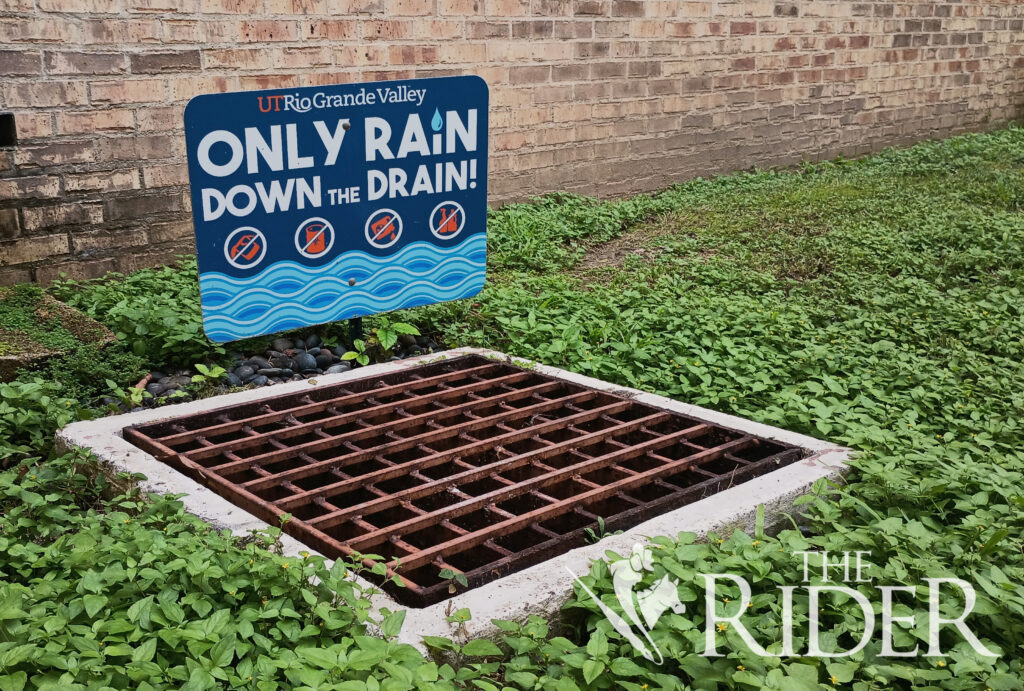University promotes ‘only rain down the drain’

An “only rain down the drain” sign sits near a storm drain on the Brownsville campus. Richard Costello, director of Environmental Health and Safety at UTRGV, said contaminants released to a storm drain can impact the Laguna Madre and Gulf of Mexico. Natalie Lapsley/THE RIDER
With the wellbeing of the local environment in mind, UTRGV has an “only rain to the drain” campaign in place, a university official says.
The university uses a Municipal Separate Storm Sewer System and regulates the release of any water to the storm drains on campus, according to Richard Costello, director of Environmental Health and Safety at UTRGV.
“There’s two mechanisms for that water to be released to the environment,” Costello said. “One is through what we call the sanitary sewer system.
“When you flush the toilet, when you turn on the water in a laboratory, for example … basically, it makes its way to a wastewater treatment plant where it’s treated and then released to the environment. And eventually, that makes its way here in the Rio Grande Valley, down to the … Gulf of Mexico and the Laguna Madre.”
Costello said 60% of the fish that go to Mexico originate from Laguna Madre, and anything that goes down the drains eventually makes its way to local waters.
“If it’s treated, it’s fine,” he said. “However, the other mechanism for releasing water to the environment is to the storm drains that you see. … [The] majority of them are located in streets, and if you look to the side, you’ll see these.”
Usually, the water collected by storm drains comes from rainfall and it is not treated as with the sanitary sewer system, so “contaminants that are released to a storm drain ultimately can impact the Laguna Madre and the Gulf of Mexico,” according to Costello.
He gave examples of contaminants that could end up in storm sewers, including trash, paint, oil, cleaning chemicals, lawn clippings and sediment from construction sites, all of which have a negative impact on the environment and marine life if it makes it to the gulf and laguna.
Costello said even pouring out drinks and debris into the grass can result in contaminants making their way to storm drains after heavy rain.
The program is reviewed by the state and there are several measures the university must comply with:
–public education and outreach, which is fulfilled by informing the community of the program
–discharge detection, which is facilitated by cameras that determine when someone has disposed of materials in storm drains
–construction site runoff control, which is mitigated by imposing control measures on any construction sites on campus
–post-construction runoff control, which ensures that runoff displaced by construction remains on campus
–pollution prevention and good housekeeping, which imposes control measures on UTRGV.
Costello said even grass, which promotes the buildup of algae, impacts the local fish population.
He added a lot of sediment is generated at construction sites and heavy rain can potentially wash it into the drains. Sediment that makes it to the laguna or gulf can get caught in fishs’ gills and kill them.
Costello said the university places silt fences around construction sites to limit sediment runoff and asks the campus community to report dismantled fences. He added those who report safety- and environmental-related issues will receive a coupon for a free lunch.
Costello said it is illegal to dispose of any type of hazardous material, such as oil and batteries, in the trash because it will eventually end up in a landfill and then it gets released to the environment.
Other examples of hazardous materials are cleaning solvents, paint, pesticides and antifreeze.
“We have what’s called the household hazardous waste program here at the university,” Costello said. “You can take these items and give it to Environmental Health and Safety. We have an agreement with the [Texas Committee on Environmental Quality], where we will dispose of that in the appropriate manner.”
To read more about stormwater runoff, visit utrgv.edu/ehsrm/programs. For more information on waste disposal, email waste@utrgv.edu.






